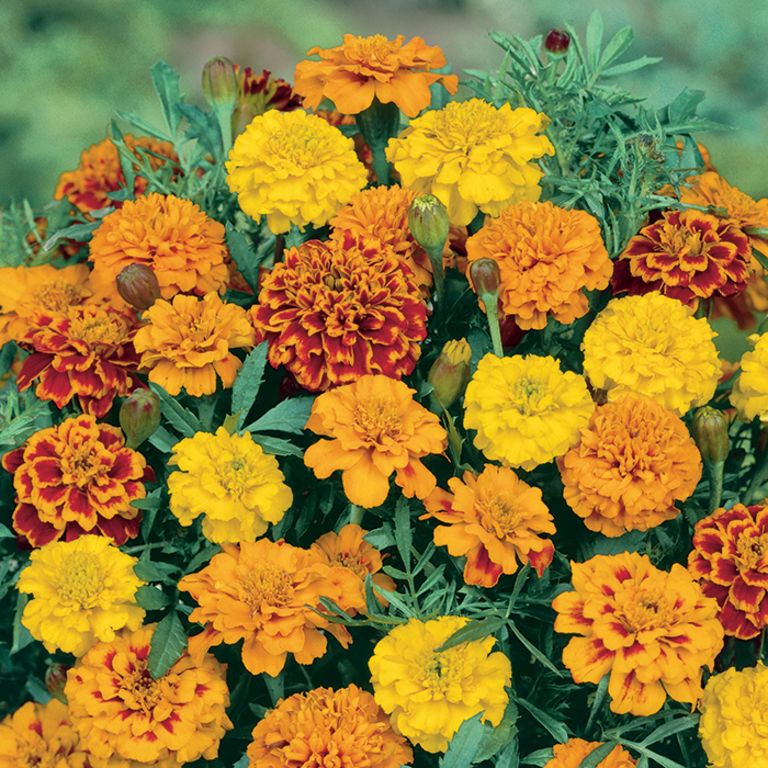"Marigolds: From Planting to Blooming"
Marigolds, beloved for their vibrant hues and easy care, bloom abundantly from spring to fall. These versatile flowers thrive in full sun with well-drained soil, requiring minimal maintenance.
Marigolds, scientifically known as Tagetes, are popular annual flowers cherished for their vibrant colors and ease of cultivation. They belong to the Asteraceae family and are native to the Americas, primarily Mexico and Central America. Marigolds in sydney have been cultivated for centuries and are widely appreciated for their ornamental beauty, versatility, and beneficial properties in gardening and agriculture.

Mexican Marigold Growing Conditions
Difficulty Rating:
Super easy to take care of, with resistance to almost all pests and diseases. Perfect for gardeners with brown thumbs.
Sunlight:
Full sun to partial sun.
Hardiness:
Down to 0°F.
Hardiness Zones:
8-11.
Soil:
- Types: Clay, loam, sand.
- Drainage: Well-drained.
- pH: Slightly acidic to slightly alkaline (including neutral).
Difficulty Rating:
Super easy to take care of, with resistance to almost all pests and diseases. Perfect for gardeners with brown thumbs.
Sunlight:
Full sun to partial sun.
Hardiness:
Down to 0°F.
Hardiness Zones:
8-11.
Soil:
- Types: Clay, loam, sand.
- Drainage: Well-drained.
- pH: Slightly acidic to slightly alkaline (including neutral).
Sunlight:
Mexican marigold thrives in environments with plenty of sunlight and should be placed under full sun. They need at least 6 hours of direct sunlight daily. Good sunlight conditions help reduce pests and diseases, significantly improving flower quality.
Soil:
Mexican marigold does not have high soil requirements. They grow better in less fertile soils and do not need a culture medium rich in organic matter. Water appropriately when the soil is dry to help the plants thrive.
Care Guide
Planting:
Mexican marigold can be sown annually. The ideal ambient temperature for sowing is above 59°F, and it can be done in spring and summer. Outdoor direct sowing is recommended, as the seeds germinate quickly. Since they won't grow until the weather warms up, the growth rate of directly sown plants is comparable to those started in indoor pots. The seeds are large and easy to sow. Cover the seeds with soil and water after sowing; small seedlings will sprout within a week. Many nurseries cultivate seedlings, so if you prefer not to sow seeds, you can buy seedlings to save time and effort.
Water
During planting, ensure regular watering. Avoid letting the soil stay dry for extended periods. In extremely sunny conditions, daily watering may be necessary. Once Mexican marigolds develop well-established root systems, they become drought-tolerant and do not need frequent watering. However, watering them once a week is recommended for bright and colorful flowers. Adjust the watering time and amount based on environmental conditions, avoiding water accumulation to prevent root rot. In very hot weather, spray newly sprouted seedlings with water to keep the soil moist.
Fertilizer
Mexican marigold is highly adaptable and generally requires no additional fertilizer unless the soil is very barren. To extend the blooming period, apply topdressing when the plants bloom in summer to increase the number of flowers. Use a special fertilizer for Compositae plants in the evening. In the 15 days leading up to blooming, this special fertilizer can be diluted and added to the soil to store the necessary nutrients for blooming and prolong the blooming period. After blooming, you can also spray a 0.5% solution of monopotassium phosphate (MKP) on the leaf surfaces.
Pruning
Mexican marigold continues to bloom throughout the entire summer. To maintain this state, regularly prune withered flowers.
Harvest
Mexican marigold can be used as cut flowers and starts blooming in early summer. They have a long blooming period, reaching full bloom in midsummer and lasting through autumn with proper care. Avoid premature harvest, as picked flowers do not easily bloom. It is best to harvest them 1-2 days before blooming, when there are 4-6 petals on a flower bud gradually opening up.
Seasonal Precautions
Mexican marigold has a long blooming period. To ensure continuous blooms throughout the summer, regularly prune withered flowers. Be vigilant for signs of disease, as these plants are susceptible to powdery mildew in humid and rainy summers.
In late summer, when nighttime temperatures drop below 40°F, the above-ground parts of the plant will begin to wither. Once the above-ground parts are completely dead, use clean scissors to cut off and remove the dead branches to prevent pests and diseases from overwintering.
Common Problems
Why is the blooming period so short?
-
Untimely Pruning:
Not pruning withered flowers regularly can affect the blooming period. Prune withered flowers to prevent nutrient consumption and promote the germination of new flowers. -
Lack of Topdressing:
Ensure topdressing is carried out as needed to provide essential nutrients and extend the blooming period. -
High Temperatures:
High temperatures can shorten the blooming period. For potted Mexican marigolds, move them to a shady place with good ventilation to help prolong blooming.
Regular care and adjustments can help maintain a longer blooming period for your Mexican marigolds.
Conclusion
Mexican marigolds are an excellent choice for gardeners of all skill levels due to their hardiness, ease of care, and long blooming period. By ensuring they receive sufficient sunlight, appropriate watering, and occasional fertilization, you can enjoy vibrant and long-lasting blooms. Regular pruning and attention to seasonal changes will keep your plants healthy and flourishing.
If you're looking to add Mexican marigolds to your garden, consider visiting Sai Nursery. They offer a variety of healthy seedlings and expert advice to help you get started. With their quality plants and guidance, you can create a beautiful, blooming garden that lasts all season long.
